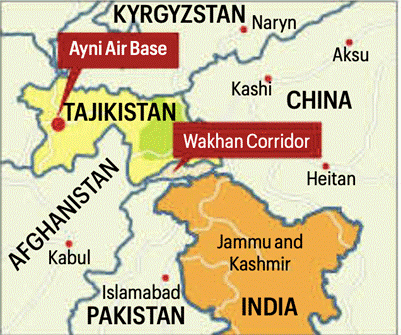Why in News ?
- India has withdrawn its military personnel and equipment from the Ayni airbase near Dushanbe, Tajikistan — its only overseas military base — after two decades of operation.
- This marks the end of India’s physical military presence in Central Asia, which had strategic implications for Afghanistan, Pakistan, and China.
Relevance:
GS 2 – International Relations
• India–Central Asia strategic cooperation and geopolitical shifts
• Balancing influence vis-à-vis China and Russia
• Impact on India’s extended neighbourhood policy
• Bilateral relations with Tajikistan and regional security architecture
GS 3 – Defence & Security
• Strategic infrastructure and overseas military logistics
• Shift towards maritime security and Indo-Pacific focus
• Defence diplomacy, counterterrorism, and regional connectivity

Background: Development of the Base
- Origin: Built during the Soviet era, the base was in poor condition after the USSR’s collapse.
- India’s Involvement:
- India began deploying military personnel in the late 1990s, assisting the Northern Alliance in Afghanistan against the Taliban.
- In 2002, India signed an agreement with Tajikistan for joint use and invested ~$80 million in renovation.
- Agencies Involved: Border Roads Organisation (BRO) handled infrastructure; Indian Air Force stationed personnel, including Su-30MKI jets.
- The base was used during humanitarian evacuations when Taliban regained control in 2021.
Strategic Significance of the Ayni Airbase
- Geographic location: ~20 km from Afghanistan’s Wakhan Corridor, which touches Pakistan-occupied Kashmir (PoK) and China’s Xinjiang province.
- Resources & Access: Tajikistan is resource-rich (uranium, gas, gold) and offers access to Central Asia, making it critical for India’s regional outreach.
- Counterbalance: Provided India a strategic foothold near Afghanistan and counterweight to China–Pakistan axis in the region.
Reasons for Withdrawal
- Reluctance of Tajikistan to renew the 2002agreement, reportedly due to:
- Increasing Chinese and Russian influence in Tajikistan.
- Tajikistan’s balancing act between India, China, and Russia.
- Geopolitical Shifts:
- U.S. withdrawal from Afghanistan (2021) reduced immediate need for proximity operations.
- Taliban’s return changed the regional security calculus.
- Operational Constraints:
- Lack of permanent control; the base remained under Tajik authority.
- Logistical challenges in maintaining supplies and operations from India.
- Cost and Strategic Recalibration:
- India may have prioritized naval expansion and maritime partnerships (e.g., Agalega, Mauritius) over continental bases.
Potential Impact
- Reduced Central Asian Footprint:
Weakens India’s direct military presence in Central Asia, an area crucial for connectivity (INSTC, Chabahar) and counterterrorism coordination. - Geopolitical Vacuum:
Opens more space for China (Belt and Road, military bases) and Russia to strengthen influence. - Loss of Strategic Leverage:
Ayni had given India symbolic parity with major powers like the US and Russia, both having regional bases.
India’s Alternate Overseas Military Presence
- Agalega (Mauritius):
India and Mauritius inaugurated an airstrip and jetty on the island; enhances surveillance over Western Indian Ocean. - Other Facilities:
- Bhutan: Indian Military Training Team (IMTRAT).
- Rashtriya Rifles and RBG (Royal Bodyguard) training in Bhutan.
- Naval outreach through coastal radar chains and logistics agreements with friendly nations (e.g., France, Oman).
Broader Strategic Context
- China’s Expansion:
- Has a military base in Djibouti and is reportedly exploring a base in Tajikistan (though unacknowledged).
- Over 100 military facilities globally.
- India’s Strategic Shift:
Moving focus from continental strategy (Afghanistan-Central Asia) to maritime strategy (Indian Ocean) — aligning with Indo-Pacific outlook.
Conclusion
- India’s withdrawal from the Ayni airbase marks a strategic retreat from Central Asia, reducing its direct military footprint in a geopolitically vital region bordering Afghanistan, China, and Pakistan.
- The move reflects Tajikistan’s growing alignment with Russia and China, limiting India’s operational autonomy despite its early investments and regional aspirations.
- It underscores a strategic shift in India’s defence posture — from seeking continental presence in Central Asia to strengthening maritime and Indo-Pacific partnerships for broader power projection.



